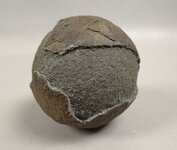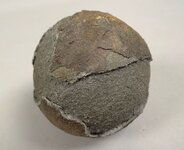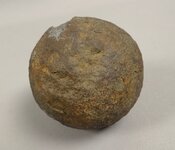It is 2.450 inches in diameter give or take based on the corroded surface which would be correct for a falcon cannon. It is non magnetic. The outer layer seems to be the same material as the inner but oxidized. It is fairly hard but can be scraped into a powder by a knife. The inner exposed part was very soft and powdery until I washed it with a toothbrush and removed the powder. It is much lighter then lead. It seems like the outer layer has oxidized to a certain depth and begun to peel off. Any ideas?
It came from the Saint Michaels area of the Eastern Shore of Maryland. See History below. I think this is a pewter cannon ball for a Falcon Cannon. It is about the right diameter. They are know but quite rare. They were cast from pewter which was very common in the 1600s to 1800s as most drinking vessels and chargers were made from pewter. When iron cannon balls ran out sometimes they cast balls from pewter. The weight is much less then lead.
The town was laid out as a speculative development in the 1770s by James Braddock. Unlike the more typical 18th century grid-pattern town planning, Braddock laid St. Michaels out around a central square. The town was incorporated in 1804.
The town played a role in the War of 1812 when, in 1813, a fleet under the command of Admiral George Cockburn moved up the Chesapeake Bay, and targeted St. Michaels because of the presence of a militia battery erected to defend the town and its shipyards. Under cover of early morning darkness on August 10, 1813, the Battle of St. Michaels commenced as the British sent a landing party ashore just south of the town, and after a brief exchange, neutralized the battery and returned to their boats. The British proceeded to bombard the town from the barges and a brig, but failed to destroy the shipyards or cause any substantial damage to the town. The militia returned fire from artillery batteries at Impy Dawson's wharf (the foot of Mulberry Street) and Mill Point (the foot of Carpenter Street). A contemporary report noted that "several houses were pierced" by the British fire. Nearly a century later a story was recorded that as a result of the town's ruse of dimming the lights and hanging lanterns in the trees beyond the town so that the cannonballs would overshoot the town, the town was spared. Based on this story, St. Michaels became known as "the town that fooled the British," a nickname selected during the sesquicentennial celebration of the battle in 1963. The Cannonball House survives as one of the structures reportedly struck by one of the shots, and is on the National Register of Historic Places, as is the Saint Michaels Historic District.



It came from the Saint Michaels area of the Eastern Shore of Maryland. See History below. I think this is a pewter cannon ball for a Falcon Cannon. It is about the right diameter. They are know but quite rare. They were cast from pewter which was very common in the 1600s to 1800s as most drinking vessels and chargers were made from pewter. When iron cannon balls ran out sometimes they cast balls from pewter. The weight is much less then lead.
The town was laid out as a speculative development in the 1770s by James Braddock. Unlike the more typical 18th century grid-pattern town planning, Braddock laid St. Michaels out around a central square. The town was incorporated in 1804.
The town played a role in the War of 1812 when, in 1813, a fleet under the command of Admiral George Cockburn moved up the Chesapeake Bay, and targeted St. Michaels because of the presence of a militia battery erected to defend the town and its shipyards. Under cover of early morning darkness on August 10, 1813, the Battle of St. Michaels commenced as the British sent a landing party ashore just south of the town, and after a brief exchange, neutralized the battery and returned to their boats. The British proceeded to bombard the town from the barges and a brig, but failed to destroy the shipyards or cause any substantial damage to the town. The militia returned fire from artillery batteries at Impy Dawson's wharf (the foot of Mulberry Street) and Mill Point (the foot of Carpenter Street). A contemporary report noted that "several houses were pierced" by the British fire. Nearly a century later a story was recorded that as a result of the town's ruse of dimming the lights and hanging lanterns in the trees beyond the town so that the cannonballs would overshoot the town, the town was spared. Based on this story, St. Michaels became known as "the town that fooled the British," a nickname selected during the sesquicentennial celebration of the battle in 1963. The Cannonball House survives as one of the structures reportedly struck by one of the shots, and is on the National Register of Historic Places, as is the Saint Michaels Historic District.



Upvote
0



